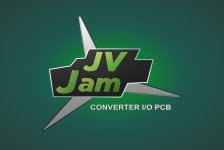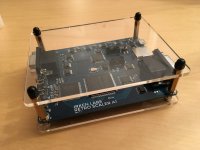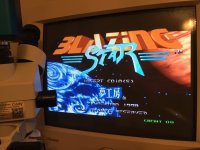You are using an out of date browser. It may not display this or other websites correctly.
You should upgrade or use an alternative browser.
You should upgrade or use an alternative browser.
- Thread starter invzim
- Start date
mm mm yum!
I mean...just sop it up with a biscuit....mm...forget about it... delicious!

Thanks for prompt and enthusiastic input 
Will keep the jammafier name for now, as it seems there will be confusion regardless
Keeping dual attenuated mono output. Attenuation of audio can be solved with so many other readily available solutions, like turning the volume down on the PCB
No extra connectors for upscalers, there really is no room + the upscaler I'm working on has VGA connector for input.

Will keep the jammafier name for now, as it seems there will be confusion regardless

Keeping dual attenuated mono output. Attenuation of audio can be solved with so many other readily available solutions, like turning the volume down on the PCB

No extra connectors for upscalers, there really is no room + the upscaler I'm working on has VGA connector for input.
Firmware updates + potential for options and config files for oddball setups.Cool idea. Wondering though what the SDcard slot does there?
PCB files sent to the manufacturer 
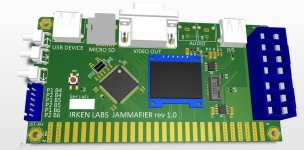
Not sure if/when this will be available, a big hurdle is the cost/feasibility of having if manufactured - the edge connector has to be done by hand, and it as a bunch of through-hole parts. Time will tell, but personally I'm really looking forward to completing this as the available alternatives are not great imho.


Not sure if/when this will be available, a big hurdle is the cost/feasibility of having if manufactured - the edge connector has to be done by hand, and it as a bunch of through-hole parts. Time will tell, but personally I'm really looking forward to completing this as the available alternatives are not great imho.
Last edited:
skate323k137
Enlightened
It really is. I'm quite lucky my namco converter still works. I'll still probably go for at least one of these.This seems like a must have for JVS cab owners. Nice work!
One of these days I plan on picking up a couple of NNC cabs - this would complement them perfectly!It really is. I'm quite lucky my namco converter still works. I'll still probably go for at least one of these.This seems like a must have for JVS cab owners. Nice work!
Maybe a kit option that leaves the through-hole stuff up to the buyer could work?it as a bunch of through-hole parts.
I'd be in for at least 4. Way too useful to not have.
I agree with JVS2JAMMA being confusing, sounds to me like you're putting a JVS setup in a JAMMA cab, and others have read it the opposite. Jammafier sounds like you're turning the cab into a JAMMA setup.
In any case, eager to see where this goes!
SNK-NEO-GEO
Enlightened
My understanding is - a JVS cabinet with a 15/24/31hkz monitor = play nice
A JVS cabinet with a 31khz monitor = needs an upscaler like OSSC or XRGBmini to play nice with 15khz Jamma PCB..
A JVS cabinet with a 31khz monitor = needs an upscaler like OSSC or XRGBmini to play nice with 15khz Jamma PCB..
it's for people who own JVS only cabs (like a Net-City) so that they can play JAMMA boards in it.So this will let 15khz JAMMA boards play nice on a 31 khz monitor in a JVS cabinet? Or am I confused?
it's really just to add JVS I/O functionality to a JAMMA board.
It does not touch the video signal, at all, but handles audio and controls. With a bit of luck, I'll manage to lock JVS requests to the Vsync of the jamma pcb, which should make it very smooth.
This guy however, touches the video signal:
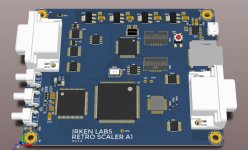
Getting the rev 1.2 proto boards next week
It's powered via USB micro, which is the reason the jammafier has a USB port so you can power it by just running a normal USB cable from jammafier to upscaler.
Power consumption of jammafier+upscaler should be about the same as the namco jvs2jamma board.
The upscaler has analog input and analog output, 30 bit color processing and zero lag. It's also optimized for arcade boards and should deal with most/all boards without any tweaking needed.
This guy however, touches the video signal:

Getting the rev 1.2 proto boards next week

It's powered via USB micro, which is the reason the jammafier has a USB port so you can power it by just running a normal USB cable from jammafier to upscaler.
Power consumption of jammafier+upscaler should be about the same as the namco jvs2jamma board.
The upscaler has analog input and analog output, 30 bit color processing and zero lag. It's also optimized for arcade boards and should deal with most/all boards without any tweaking needed.
Surely it attenuates the video signal from TTL to standard "VGA" levels ?It does not touch the video signal, at all, but handles audio and controls. With a bit of luck, I'll manage to lock JVS requests to the Vsync of the jamma pcb, which should make it very smooth.
It does not, rationale being that RGB signals attenuated to 0.7/1V while keeping the impedance of the PCB would result in a is a non-standard. Arcade PCB's have really different output impedance, and doing this would introduce yet another 'unknown'.Surely it attenuates the video signal from TTL to standard "VGA" levels ?It does not touch the video signal, at all, but handles audio and controls. With a bit of luck, I'll manage to lock JVS requests to the Vsync of the jamma pcb, which should make it very smooth.
The subject matter is complicated enough as it is, and I would rather not complicate things by 'silently' modifying a 'known' signal into something else. Add to this the mess that is sync.
The Riverservice alters the video signal by adding 75 Ohm termination, but you will feed the signal to either an upscaler or monitor that has it's own termination - which will probably imply a 37.5 ohm load on the RGB lines which can lead to strange results.
The Namco alters the video signal by amplifying the signal, giving it 75 ohm IMPEDANCE, while only attenuating it a little - resulting in 75 ohm impedance with about 0-3V VPP RGB levels. The re-amplification adds noticeable image degradation, for 'no good reason'.
The Konami AFAIK attenuates it to VGA levels, not sure about the impdance of it - but does not touch the SYNC?
From a support and technical perspective, I concluded that it would be better to do nothing - as people will have to deal with arcade RGB/SYNC in some fashion regardless, and I would rather not alter the signal and add complexity to the video chain.
SNK-NEO-GEO
Enlightened
Do you have more info on this please.. what max resolution does it scale to? Is it something like the xrgb2 performance wise but easier to use? what max resolution does it support? Maybe send both units to a member here with time and knowledge to do a proper review?It does not touch the video signal, at all, but handles audio and controls. With a bit of luck, I'll manage to lock JVS requests to the Vsync of the jamma pcb, which should make it very smooth.
This guy however, touches the video signal:
Getting the rev 1.2 proto boards next week
It's powered via USB micro, which is the reason the jammafier has a USB port so you can power it by just running a normal USB cable from jammafier to upscaler.
Power consumption of jammafier+upscaler should be about the same as the namco jvs2jamma board.
The upscaler has analog input and analog output, 30 bit color processing and zero lag. It's also optimized for arcade boards and should deal with most/all boards without any tweaking needed.
Would be a great option.Maybe a kit option that leaves the through-hole stuff up to the buyer could work?it as a bunch of through-hole parts.
It's very much a work-in-progress, and there have been a few revisions so far. It was started before the OSSC was released, but in nature it's similar in that it's a line-doubler. Making an upscaler is not for the easily discouragedDo you have more info on this please.. what max resolution does it scale to? Is it something like the xrgb2 performance wise but easier to use? what max resolution does it support? Maybe send both units to a member here with time and knowledge to do a proper review?

Main difference from the OSSC is:
- Dedicated sync processing input stage to deal with weird sync scenarios (no touch automagic)
- High impedance& Level RGB input / low impedance&level rgb input - selectable
- TTL sync / 0.7V sync - selectable
- 30 Bit analog input
- 30 bit analog output
- Different ADC than the OSSC
- Analog pass-thru, so if sync is e.g. 31k - it will pass it through without alteration
- on-screen display (WIP, haven't actually written the code for this yet)
It's really made for CRT's, as an alternative to XRGB2 and the like for 31k CRT's, but with special focus on arcade pcb's. Comparing to XRGB2, this one has a sharper image and is more stable - it CAN look a bit like mame on an LCD, but of course there will be scanlines and whatnot.
I'll probably make a thread once the new revision is assembled and development continues.
Edit: couple of CRT shots, harder to get a good photo:
Attachments
Last edited:

